Diving with Bubble Corals
Lanta Marine Life | Euphyllidae
There are several species of Bubble Corals found in the Indo-Pacific area, some of which we can find here on the dive sites around Koh Lanta.
Bubble Corals can be mistaken for soft corals, however they have a hard, stony skeleton just below the surface. The 'bubbles' are known as vesicles which inflate with liquid during the day to capture sunlight for photosynthesis. During the night, the vesicles deflate and are withdrawn, and the feeding tentacles emerge.
Individuals of the same species can look slightly different, depending on the inflation of the vesicles (bubbles), and the environment in which they are found, however they are fairly easy to identify, as each of the species present at our dive sites is quite different from the others and has distinct vesicles and skeleton growth.
2 species found on this page:
Grape Coral
(Plerogyra sinuosa)
Grape Corals are easy to identify and are very abundant at the dive sites and reefs around Koh Lanta. This species forms small to very large colonies in both shallow, and deeper water.
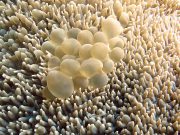
Plerogyra sinuosa @ Koh Bida
During the day, Grape Coral colonies show inflated, grape-sized, bubble-like, vesicles which are almost transparent and are filled with the symbiotic algae zooxanthellae.
During the day, these vesicles are exposed to sunlight, producing oxygen and food for the coral polyps.
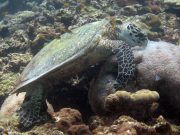
Hawksbill Turtle's favourite food @ Koh Rok
Grape Coral vesicles are inflated or deflated depending on the amount of light available and colonies can look quite different depending on the level of inflation. At night, Grape Coral vesicles are deflated and retracted, with the feeding tentacles then extended to catch plankton.
The skeleton of Grape Coral colonies forms inverted cones of meandroid winding ribs and valleys which can be seen when the vesicles are retracted, or when part of the colony is damaged/broken.
Hammer Coral
(Euphyllia ancora)
Hammer Coral has puffy tubular polyps with T-shaped tips which are extended both day and night to varying lengths, but cannot be retracted, making this an easily identified coral species. The polyp tips contain zooxanthellae and vary in colour from a light cream through to orange, green and brown.
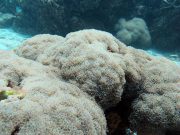
Euphyllia ancora colonies @ Koh Haa
Hammer Coral polyps are arranged in meandroid rows, usually in colonies up to a meter across.
At some dive sites such as Koh Haa and Koh Rok, multiple colonies form together to cover many meters of substrate. Hammer Coral polyps can give a nasty sting if touched by humans.
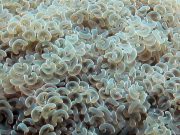
Euphyllia ancora @ Koh Haa
As with other bubble coral species, Hawksbill Turtles love to eat Hammer Coral polyps.
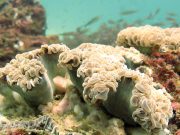
Euphyllia ancora @ Koh Haa
Diving with Bubble Corals around Koh Lanta
Scuba Diving & Snorkel Trips
If you'd love a chance to spot Bubble Corals on one of our daily high season diving trips from Koh Lanta then send us an email to info@diveandrelax.com.
Join our high season speedboat dive trips to some of Thailand's best dive sites and enjoy small groups, short journey times, with a focus on great personal service, safety and fun.
Not yet a certified diver? Learn to Scuba Dive on Koh Lanta with the 3 day SSI Open Water Diver course.
Book online to save 10% on dive trips and scuba courses on Koh Lanta.
Find Out More
Indo-Pacific Marine Life Guides
- Allen, G., Steene, R., Humann, P., DeLoach, N. (2003) Reef Fish Identification, Tropical Pacific. Jacksonville, FL., USA: New World Publications, Inc., ISBN 1-878348-36-1.
- Humann, P., DeLoach, N., (2010) Reef Creature Identification, Tropical Pacific. Jacksonville, FL., USA: New World Publications Inc., ISBN 978-1-878348-44-9
- Debelius, H. (2013) Indian Ocean Reef Guide. Frankfurt, Germany: IKAN - Unterwasserarchiv, ISBN 978-3-939767-52-7.
- Debelius, H. (2004) Nudibranchs and Sea Snails, Indo-Pacific Field Guide. Frankfurt, Germany: IKAN - Unterwasserarchiv, ISBN 3-925919-51-1
- Erhardt, H., Knop, D. (2015) Corals Indo-Pacific Field Guide. Frankfurt, Germany: IKAN - Unterwasserarchiv, ISBN 3-925919-69-4.
- Veron J.E.N., Stafford-Smith M.G., Turak E. and DeVantier L.M. (2016). Corals of the World
